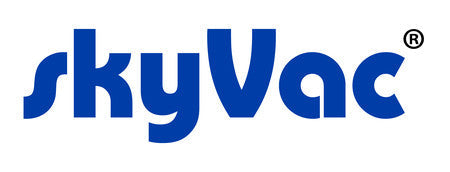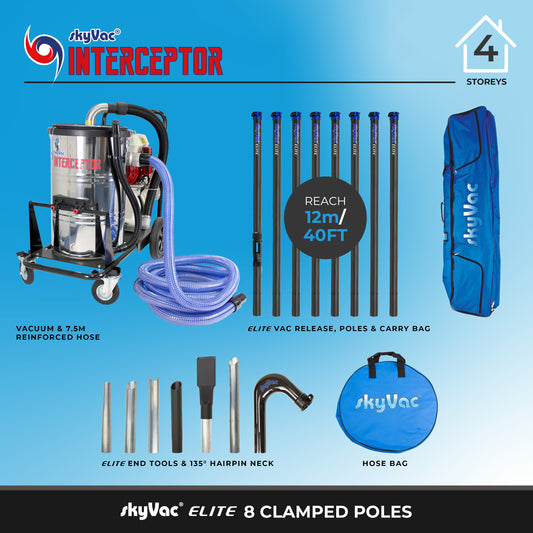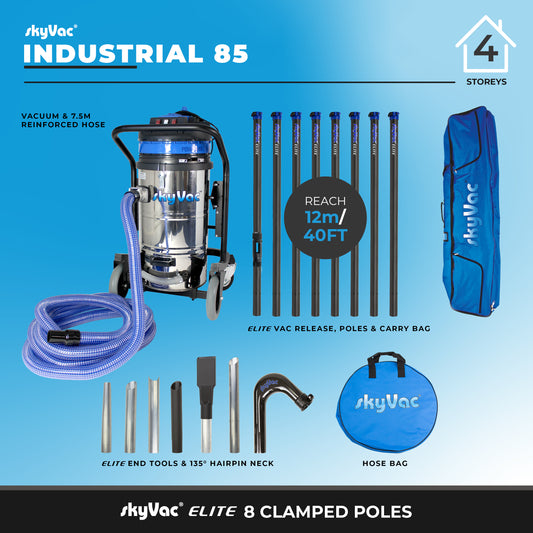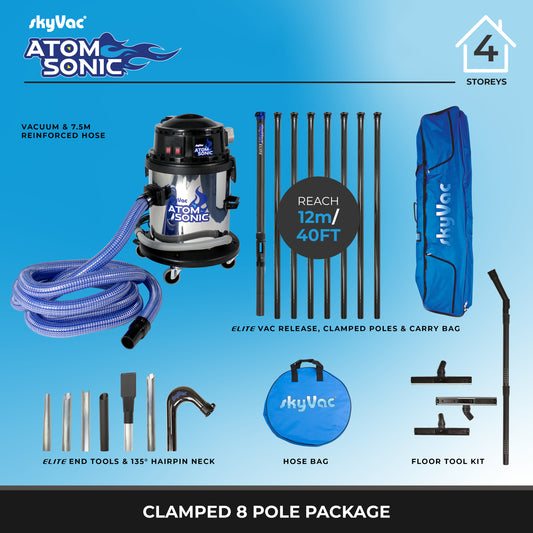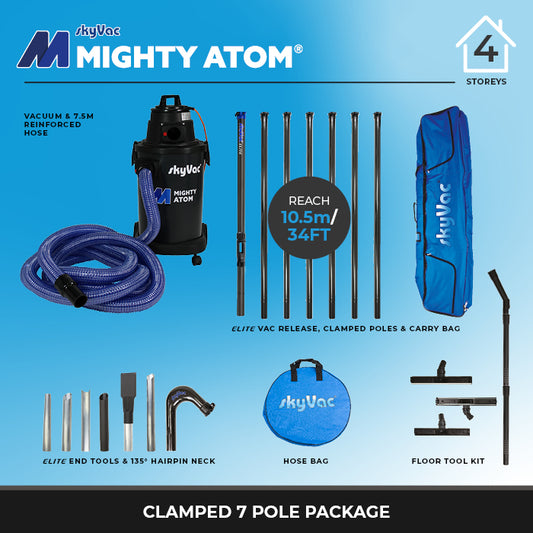Dominando la limpieza de zonas con polvo en altura: Tu guía definitiva
Compartir
Todos sabemos que el polvo parece aparecer mágicamente por todas partes, pero ¿te has fijado en cuánto se acumula en las alturas? Las esquinas del techo, las aspas de los ventiladores y las tuberías pueden convertirse en imanes para el polvo. Es fácil olvidarse de ellos, pero dejar que se acumule puede causar todo tipo de problemas. En esta guía, te explicaremos cómo limpiar eficazmente el polvo acumulado en altura, para que tus espacios sean más limpios y saludables.
Conclusiones clave
- Las zonas con alta acumulación de polvo, como los techos y los conductos de ventilación, acumulan polvo y caspa que pueden afectar la calidad del aire y suponer un riesgo de incendio si no se limpian.
- Para una limpieza segura y eficaz del polvo en altura desde el nivel del suelo, se necesitan herramientas especializadas, como pértigas extensibles y sistemas de aspiración (como los de SkyVac).
- La limpieza regular de polvo en altura, combinada con las medidas de seguridad adecuadas y el mantenimiento de las herramientas, es vital para mantener un ambiente limpio, saludable y profesional.
Comprender la importancia de la limpieza de zonas con mucho polvo
Solemos centrarnos en los suelos y las superficies con las que interactuamos a diario, pero ¿qué ocurre en las zonas altas? El polvo, las telarañas y otros residuos tienden a acumularse en lugares de difícil acceso, como las vigas del techo, las lámparas y la parte superior de los armarios. Esto no es solo un problema estético; puede afectar a la calidad del aire que respiramos e incluso suponer un riesgo para la seguridad.
¿Por qué se acumulan el polvo y la caspa en los lugares altos?
Piense en cómo se mueve el aire en un edificio. Los sistemas de calefacción y refrigeración, el tránsito de personas e incluso abrir una puerta pueden levantar partículas diminutas. Debido a su ligereza, estas partículas tienden a ascender. Con el tiempo, se depositan en repisas, esquinas y cualquier superficie horizontal que no estorbe. Esto incluye:
- La parte superior de los estantes y armarios
- Ventiladores de techo y lámparas
- conductos y rejillas de ventilación del sistema de climatización
- Vigas y cabrios estructurales
- bordes y esquinas de la pared superior
Estas zonas se convierten en un punto de acumulación de polvo, caspa de mascotas y otros alérgenos. Si se dejan sin limpiar durante mucho tiempo, la acumulación puede llegar a ser considerable.
La circulación constante del aire dentro de un edificio transporta naturalmente partículas finas hacia arriba. Estas partículas, una vez suspendidas en el aire, terminan depositándose en los puntos más altos, a menudo los más desatendidos. Esto crea un depósito oculto de polvo y posibles alérgenos que, de no corregirse, puede afectar la calidad del aire interior.
El impacto de las áreas aéreas descuidadas
Ignorar estas zonas de polvo en altura puede acarrear varios problemas. Para empezar, afecta la calidad del aire. Cuando el polvo y los alérgenos se acumulan, pueden volver a dispersarse en el aire, lo que podría provocar alergias o problemas respiratorios en personas sensibles. Además, supone un riesgo de incendio; el polvo es combustible y una capa gruesa alrededor de componentes eléctricos o fuentes de calor no es lo ideal. Y, seamos sinceros, el polvo visible en lugares altos no da una imagen profesional ni de limpieza. Puede causar una mala impresión, sobre todo en entornos comerciales o de atención al cliente. La limpieza periódica de estas zonas contribuye a mantener un espacio más saludable, seguro y presentable para todos.
Herramientas y técnicas esenciales para la limpieza de zonas con mucho polvo
Cuando hablamos de limpiar esos rincones de difícil acceso en lo alto, no basta con tener un palo largo. Necesitamos el equipo adecuado y algo de experiencia para hacerlo de forma segura y eficaz. Pensemos en los ventiladores de techo, las lámparas y las vigas: pueden acumular muchísimo polvo.
Cómo elegir los sistemas de limpieza de polvo adecuados
Conseguir el equipo adecuado es el primer paso fundamental. Hemos comprobado que usar sistemas especializados marca la diferencia. Para nosotros, se trata de contar con herramientas que nos permitan alcanzar nuestras metas sin necesidad de usar escaleras o andamios. Aquí es donde sistemas como SkyVac realmente destacan.
- Pértigas telescópicas: Son revolucionarias. Fabricadas con materiales ligeros como la fibra de carbono, se extienden a alturas impresionantes, a veces hasta 12 metros. Esto nos permite realizar la mayoría de los trabajos de limpieza de polvo en altura con total seguridad desde el suelo.
- Accesorios para aspiradoras: Simplemente esparcir el polvo no es lo ideal. Preferimos sistemas que se conecten a aspiradoras, especialmente aquellas con filtros HEPA. De esta manera, no solo levantamos el polvo, sino que lo capturamos.
- Cepillos y cabezales especializados: Cada superficie requiere herramientas específicas. Utilizamos una variedad de cepillos, desde suaves para accesorios delicados hasta más rígidos para vigas. Algunos cabezales están diseñados para acceder a rincones estrechos o alrededor de tuberías.
Dominar las técnicas de limpieza en zonas con alto nivel de polvo
Una vez que tenemos las herramientas, lo importante es cómo las usamos. Una buena técnica se traduce en un espacio más limpio y un trabajo más seguro.
- Trabaja de arriba abajo: Empieza siempre desde el punto más alto y ve bajando. De esta forma, el polvo que caiga se depositará en una zona que aún no hayas limpiado, evitando así tener que volver a limpiar.
- Movimientos controlados: Al usar pértigas largas, muévase lenta y deliberadamente. Los movimientos bruscos pueden levantar polvo por todas partes y dificultar el control de la pértiga.
- Aproveche la potencia de la aspiradora: Si usa una aspiradora, asegúrese de que esté encendida y configurada al nivel de succión adecuado. Para el polvo o las telarañas más difíciles de quitar, un poco más de succión puede ser de gran ayuda.
- Inspecciona a medida que avanzas: Muchos sistemas de gran alcance permiten acoplar accesorios como cámaras o espejos. Estos son muy útiles para comprobar si has eliminado todo el polvo, especialmente en zonas de difícil acceso.
Utilizar las herramientas y técnicas adecuadas no solo facilita el trabajo, sino que también mejora significativamente la calidad del aire en el espacio al eliminar el polvo y los alérgenos acumulados en esos lugares altos que a menudo se olvidan.
Mantener un ambiente limpio con limpieza profunda
Mantener nuestros espacios limpios va más allá de lo que vemos a simple vista. El desempolvado regular en altura es fundamental para un ambiente realmente limpio y saludable. Hemos comprobado que mantener una rutina marca una gran diferencia, no solo en el aspecto de un lugar, sino también en la calidad del aire que todos respiramos.
Mejores prácticas para la limpieza regular de zonas con mucho polvo
Para mantener libres de polvo y suciedad esos rincones de difícil acceso, hemos desarrollado algunos hábitos que realmente funcionan:
- Planifícalo: No esperes a ver telarañas. Establece un programa de limpieza regular, quizás mensual o trimestral, según el área. Esto evita la acumulación de suciedad y hace que cada limpieza sea más rápida.
- Trabaja de arriba abajo: empieza siempre por lo más alto y ve bajando. De esta forma, el polvo que se desprenda caerá sobre superficies que aún no se han limpiado, evitando así tener que volver a limpiar las mismas zonas.
- Utilice las herramientas adecuadas: para ello, confiamos en nuestros sistemas SkyVac. Los postes extensibles nos permiten limpiar desde el suelo, lo que es más seguro y eficiente que usar escaleras. Además, los accesorios de aspiración capturan el polvo al instante.
- Limpie sus herramientas: Después de cada uso, asegúrese de limpiar los cepillos, los mangos y los filtros de la aspiradora. Esto mantendrá su equipo en buen estado y evitará que el polvo se disperse.
Garantizar la seguridad durante las operaciones de limpieza con alto contenido de polvo
La seguridad es siempre nuestra máxima prioridad cuando trabajamos en altura, incluso con equipos especializados. Así es como nos aseguramos de que todos estén seguros:
- Manténgase firme: La mayor ventaja en seguridad es utilizar sistemas de aspiración de gran alcance como SkyVac. Esto significa que podemos limpiar techos, vigas y conductos desde el suelo, evitando por completo los riesgos asociados con las escaleras y los andamios.
- Presta atención a tu entorno: incluso al trabajar desde el suelo, ten cuidado al usar pértigas o aspiradoras. Asegúrate de que no haya personas, objetos frágiles ni riesgos eléctricos en las inmediaciones.
- Equipo de protección personal (EPP): Aunque no estemos escalando, seguimos usando gafas de seguridad para proteger nuestros ojos de cualquier partícula de polvo que pueda levantarse. Si trabaja en una zona con posibles riesgos, consulte siempre el EPP recomendado.
Mantener un ambiente limpio no es solo una cuestión estética; también es fundamental para la salud y la seguridad. Al incorporar la limpieza regular de superficies altas a nuestras rutinas de limpieza y utilizar el equipo adecuado, podemos mejorar significativamente la calidad del aire y reducir los posibles riesgos. Es un enfoque proactivo que, a la larga, beneficia a todos.
Mantener tu espacio libre de polvo, sobre todo en los rincones más difíciles, es fundamental para un ambiente saludable. Nuestras herramientas facilitan la limpieza de polvo en altura, dejando tu área limpia y fresca. ¿Quieres ver cómo podemos ayudarte a mantener un ambiente impecable? ¡Visita nuestra página web hoy mismo para descubrir nuestras soluciones!
Concluimos nuestro viaje de limpieza de polvo en altura
Ya hemos hablado bastante sobre cómo eliminar el polvo y la suciedad de las alturas. Puede parecer una tarea ardua, pero con las herramientas adecuadas y un poco de conocimiento, podemos lograr grandes resultados. Recuerda que mantener limpios los lugares altos no solo se trata de estética, sino también de la calidad del aire y la seguridad. Hemos visto cómo sistemas como SkyVac facilitan y hacen más segura esta tarea, permitiéndonos trabajar desde el suelo. Esperamos que esta guía te haya dado la confianza y la información necesarias para dominar la limpieza de polvo en altura. ¡Ahora, a por todas y a conquistar esas alturas llenas de polvo!
Preguntas frecuentes
¿Cómo accedemos a esos lugares tan altos para realizar la limpieza?
Utilizamos pértigas especiales muy largas, hechas de materiales ligeros como la fibra de carbono. Estas pértigas pueden alcanzar gran altura, ¡a veces hasta 12 metros! Esto nos permite limpiar techos, luminarias y vigas sin necesidad de escaleras ni plataformas elevadoras, lo que resulta mucho más seguro y rápido.
¿Qué ocurre con todo el polvo que limpiamos?
Al limpiar lugares altos, sobre todo con nuestros sistemas de aspiración, capturamos el polvo al instante. Utilizamos accesorios especiales que se conectan a aspiradoras potentes, a menudo con filtros HEPA. Esto atrapa el polvo y los alérgenos para que no se dispersen y contaminen el aire. Para la limpieza en seco, utilizamos cepillos y paños especiales que atrapan el polvo.
¿Es seguro el desempolvado a gran altura en todo tipo de lugares, como por ejemplo donde manipulamos alimentos?
¡Sí, así es! Contamos con herramientas y métodos especiales para áreas sensibles. Utilizamos paños de microfibra lavables y aspiradoras con filtro HEPA para garantizar una limpieza adecuada y segura, cumpliendo con todas las normativas para lugares como áreas de procesamiento de alimentos o salas blancas.
